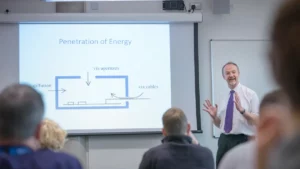
Most people spend around 80% of each day indoors, often in buildings designed for economy of space or profit. But what about designing for health and happiness? Dak Kopec, Director of the Design for Human Health program at the Boston Architectural College, asks the million-dollar question: how might we design our buildings in ways that suit the purposes of the space as well as our own health and well-being?
You have a broad background spanning psychology, public health, and the structured environment. How exactly do you combine these fields in your day-to-day work? I conduct environmental assessments to determine how the built environment supports health and well-being. My undergraduate degree is in public health, and I have always been interested in the relationship between the built environment and human behavior. Believe it or not, we can determine health outcomes by assessing people’s environments. I ultimately went on to get graduate degrees in Architecture, Community Psychology and Environmental Psychology. What makes me unique in my day-to-day work is that understanding of human biology and psychology in relation to the way we design and live within the built environment.
The bulk of my work comes from medical referrals and from individuals interested in user-centered design, such as parents with children who suffer from autism or asthma. I start with an environmental analysis based on the end users that occupy the environment. Then I look to see how the environment will support the activities and behaviors of the users. Finally, I develop a design that promotes the safety and health-enhancing priorities of the occupants.
You’ve worked in Qatar, Costa Rica, Hawaii and all over the US. What differences have you found in how different cultures interact with their built environment? Have you seen the reception or understanding of this type of work differ?
I find the Middle East to be pretty progressive. They seem to have a comprehensive understanding of the built environment because they’re relatively new to the scene; Dubai has literally grown up out of the sand in the last few decades, and Doha has done the same. So they don’t have to do retrofits, because they can do it right from the beginning. However, these cities do struggle with disability access and do have room for improvements.
Costa Rica and Hawaii suffer from financial limitations that prevent them achieving some of their goals. In many ways they struggle just to meet the basic functional needs of their communities, so taking a look at enhancing health through prevention hasn’t been able to happen yet.
The most progressive regions from my perspective are Europe and Canada. Canada has embraced the health and well-being movement within Architecture and Interior Design with incredible fervor. The US does well with exterior design and city planning (like walkability and air pollution), but there is not as much focus on interior work. To me this is a shame, as the EPA says we’re spending 80% of our time indoors. The biggest hurdle to refocusing on interior work is that the designer must have a strong understanding of human biology, psychology and design. Many US universities could do more to promote interdisciplinary thinking.
I haven’t seen anything quite like the Design for Human Health program before! Can you tell me a little more about this rising field?
There are some people with specific needs that are seeking out professionals in this field. Unfortunately there are many who still don’t know these services exist, how to find these services, or determine what makes a person qualified to do this work. Clinical healthcare professionals, for example, understand the biology and biomechanics of human functioning but they lack the psychological knowledge to know when a design might trigger learned helplessness or other poor health behaviors, and they lack the structural knowledge to know how to effectively modify an environment to support a person with a specific health condition. Rather than hiring three professionals (Occupational Therapist, Psychologist, and Architect/Interior Designer), the goal of the Design for Human Health Program at the Boston Architectural College is to develop professionals that address an environment from all of these perspectives equally and to develop an environment that supports its occupants without any visual clues that a person may have a problem. In short, the space shouldn’t look like someone with a disability occupies it. This is where good design is important!
How do you see the built environment and natural environments best interacting?
If I had things my way, I would make sure we did more outside, including education and job duties. I would have schools geared toward outdoor participatory learning activities, relying on nature to provide essential learning tools. I’d teach physics and architecture through building forts and teepees, and I’d teach evolutionary concepts by watching a pollywog morph into a frog, or a caterpillar into a butterfly.
Unfortunately, this possibility diminishes every day because many people are leaving the rural environment to live in cities. That means that, as designers, we need to find ways to mimic nature as much as possible, and do it in an organic way that allows young people to explore and learn valuable lessons that past generations learned simply through the act of play. As adults, we’ve come to appreciate and even prefer overly organized environments – think Central Park. There are natural elements, but you can stay on concrete and not worry about getting your shoes dirty if you don’t want to. As a society we need to recognize that we are moving toward urban societies which heavily feature busses, stores, subway, homes, and assorted public buildings and we need to look at how to design these places to support human health and well-being.
What can people do on their own?
We need to think about health in a balanced way. There are reasons we might need to see a medical doctor, and we should! There are reasons we should see a counselor or therapist, and we should do that too! But we shouldn’t be looking at pills as a magic bullet; we need to look at our lives as a whole, and this includes the built environments we inhabit.
For example, we are experiencing an epidemic of depression and widespread use of selective serotonin re-uptake inhibitors (SSRIs) to treat it. But serotonin is also produced by spending time in the sun and being active. So rather than looking at drug therapies in isolation, we should also think about how we might make someone’s environment better. If we could focus on getting more fresh air, more time outside, and some therapy to help people cope with day-to-day situations, maybe we wouldn’t need pharmaceuticals, or perhaps a lower dosage!
My advice is to look at your environment, and ask yourself: Do I feel good? Do I want to work? Do I like myself in this place? What does this space say about me? And does my environment say want it to say? We need to think about our needs and ourselves comprehensively; to do this we must address our biology, our social environment, and our physical environments.
Thank you for sharing your time and insights with us, Dak! For more on Dak’s work, check out his TEDxSacramento talk and website.
Related Post
Categories
Recent Articles

Expert Interviews: The Secret Weapon for Winning Product Strategy

Unlock Workforce Potential with Open Talent Networks | Boost Efficiency & Innovation

Has the world of consulting changed forever?

Internal talent marketplace

Experts on demand

